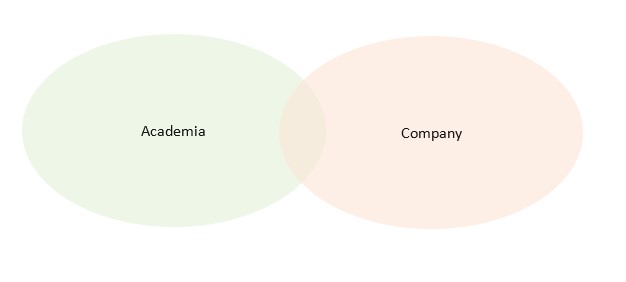When you jump from pure academic research to corporate applied-research, you inevitably end-up starting each and every single sentence with a shy:
Clearly, it is not the same
That’s the truth, it is not the same indeed. Inevitably, pace, organization, methods and goals have different angles when observed from the two points of view. Should we represent it visually, it would likely have this very qualitative and arbitrarily shaped diagram:

Of course, diversity could be stretched from several different directions, as well as have different polarities, both positively and negatively (all asterisks applied). Companies aren’t usually meant for carrying scientific research, but often, when it is done, it is based on axioms and methodologies derived from academic work. It all becomes like an affective relationship, where everything is a game where the goal is the compromise between idealism and pragmatism, indisputable strictness and pragmatic flexibility. Instinctively, when we talk about accepting a compromise, we usually tend to assume that one of the two point of views is good, while the other does represent something bad, wherewith we have to make a contact, possibly without colliding. Though, this is not the case. This time, all the involved actors have a positive connotation. Strictness is necessary in order to produce results that are replicable, truthful and even rebuttable. On the other hand, flexibility is as crucial as it is strictness. While the latter allows for robust results by controlling all the variables, an obsessive control carries the risk of creating a laboratory bubble. The world needs idealists, without whom we would live out of instincts, just as much as the world needs people that are pragmatic, people that can keep the other group from “flying away”, capable to translate ideas into facts, concepts into actions.
Achieving quality: a path made of research, foresight and some conflicts
TSW does have a non-written recipe which determines the balance between the parts. It takes passion, it takes dedication and yes, conflict as well. On one hand, there are strict timings and multi-colored requests; on the other, there is a research team -or even better- a team called TSW, that works in a continuous pursuit of quality. This is one of the primary ways of being different and of great value, for those who decide to take a path together with us. Along that path there will be times where we have to say “no”. That “no”, does represent the way we work. It does represent our way to listen, like a sincere friend. A friend who has the courage of telling you whether a path is wrong, while being able to point towards the best way for you. An alternative path, one that is more courageous, perhaps even crazier and yet, of a greater value. In order to invest in quality, you need courage, intelligence and a long-term outlook. Quality is not an easy friend. She doesn’t always support you. She comes with you, but also, she has always something to say, always. As such, not everyone is ready for this type of companion and yet, no one will ever advertise the opposite. There isn’t even really a specific word to represent the absence of quality and no, quantity is not a valid option, it is not that easy.
So, basically this is what I found in TSW. This is what I found after that small and yet big jump from the Academia. I found balance between hurry and calmness, strictness and reality, profit and value… in other words, “quality”.
Therefore, from now on, how can we start that incipit? Perhaps, it is not that difficult after all, because…
Clearly, it is not the same. But…